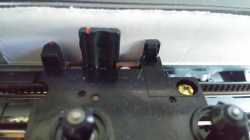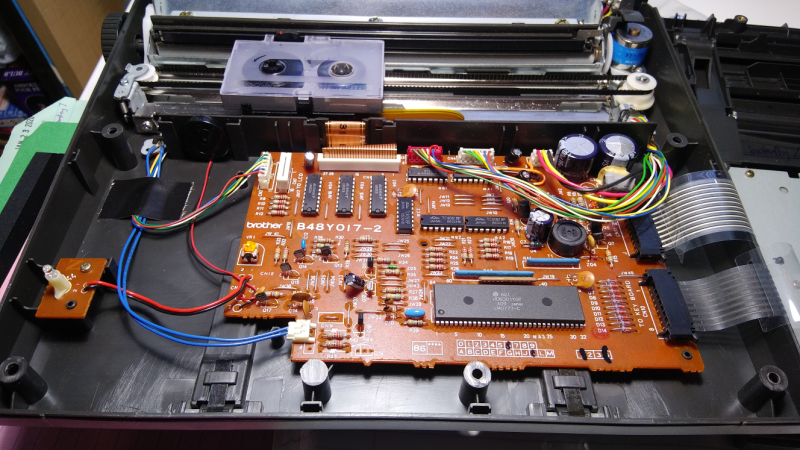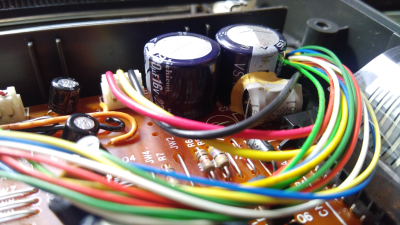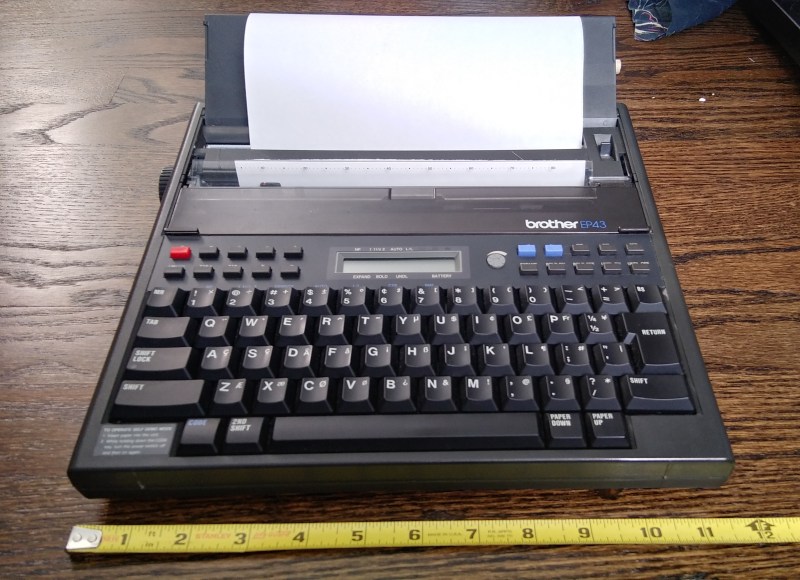A few months ago, I fell down the internet rabbit hole known as Ted Munk’s typewriter site. I don’t remember if I just saw this Brother EP43 typewriter for sale and searched for information about them, or went looking for one after reading about them. Either way, the result is the same — I gained a typewriter.
Now I’m not really a typewriter collector or anything, and this is my first word processor typewriter. When it arrived from Goodwill, I anxiously popped four ‘C’ cells in and hoped for the best. It made a print head noise, so that was a good sign. But almost immediately after that, there was a BANG! and then a puff of smoke wafted out from the innards. My tiny typewriter was toast.
21st Century Typewriter
Speaking of toast, this typewriter is thermal, which is why it takes such awesome battery power. Thermal is probably the absolute best feature it could possibly have, because as long as there is electricity and thermal fax paper to be had on Earth, this typewriter can be used endlessly, no ribbon necessary. And that’s a good thing, considering that replacement ribbon cassettes are about $95 each.
There are a ton of other reasons that this typewriter is still awesome today. First off, the obvious: distraction-free typing. Like all word processors, you get a buffer of characters that can be corrected before they’re committed to paper.
It’s very small and lightweight compared to most typewriters and word processors. Really, it’s the pinnacle of print on demand. Seriously, the only thing smaller that qualifies is an embossing label maker or Braille writer.
As you can see by the demo sheet, there are a ton of word processing features that take the guesswork out of making documents look pretty. It does bold, underline, and right margin flush with just a few extra keystrokes. There’s even a four-banger calculator if your adding machine is too far out of reach!
 Physically speaking, the whole thing is adorable, especially the little print head. And it has ISO enter, which is labeled RETURN. I keep meaning to cut some of my fax roll down into sheets, but once I made a paper dispenser with two 3D printed triangles and a dowel rod, I was far less motivated. Also, it’s really easy to tear the paper off by just tearing it against the clear plastic ruler guide.
Physically speaking, the whole thing is adorable, especially the little print head. And it has ISO enter, which is labeled RETURN. I keep meaning to cut some of my fax roll down into sheets, but once I made a paper dispenser with two 3D printed triangles and a dowel rod, I was far less motivated. Also, it’s really easy to tear the paper off by just tearing it against the clear plastic ruler guide.
The only real cons of this machine are that I can’t connect it to a computer, and I can’t connect a more ergonomic keyboard to her. I’m good for about a page, single-spaced, and then my wrists start complaining.
Back to the Smoke Monster


After I opened it up and surveyed the damage, I found that one of the big capacitors had been what blew. I decided to just order all new electrolytics for it to get ahead of future problems. This was especially wise considering how difficult this thing is to put it back together. The plastic ribbon cables are quite fiddly.
In the end, I replaced all but two of the electrolytics. One of them I just couldn’t find a replacement for. The other I couldn’t replace because the one I ordered ended up having too big of a footprint. I was so focused on getting short-enough replacements for the big boys, that I screwed that one up completely.
After replacing the caps I got my Hello, World on. Now I type on it whenever I can, usually about once a day. Naturally, I think more fondly of it because I nursed it back to health. Here’s to another thirty or forty years of distraction-free clacking, thermal-paper supply willing!

















I spy with my little eye … an HD6301. (Hitachi’s variant of Motorola’s 6800 series microcontroller)
Considered converting it to i.e. USB power? For a stationary thing like this, might make sense so that you don’t need to change batteries from time to time. And if you’re ever to try and figure out a way to connect it to a computer, the data pins in the USB cable will be there, waiting ;-P
You should buy a wrist rest (or whatever it is its name in english for that long cushion made of gel that you put in front of the keyboard and allow you to rest over it your wrists :-D ). Since I started using them for both keyboard and mice, my wrist problems literally disappeared.
If your wrists hurt from typing, you’re doing it wrong.
You don’t need a bacteria accumulating gel pad to fix your issues.
Well obviously if you’re in pain something is wrong. But physiology and technique vary from person to person and so solutions vary as well. If a gel pad didn’t work for you it doesn’t mean it won’t work for others.
Not sure what you’re getting on about regarding bacteria. Keyboards are filthy in general.
I used this (or one of its direct lineage forebearers) for a little while many many many many many winters ago. It was not destined to be my friend. My biggest issue was the slight delay it had when pressing a key and the print head moving (to allow for correcting mistakes, or in the case of Japanese, to pick the the right character). But it sure was pretty compared to the thousand pound monsters folks back then called portable computers.
I have a similar one, made by Casio (Casiowriter CW16). Aside the now unobtainable cassetes, I had trouble finding a suitable external power source for it – and draining four D-cells quickly is terrible.
Started thinking about some way to connect it to a computer (maybe hooking an ESP or arduino-ish mc to the keyboard pins rather than interfacing it with the memory/processor), but got way too lazy… after all, it would turn into a slow noisy text-only thermal printer…
…which, by the way, would also be fun as a completely useless log printer. :D
I had trouble finding a suitable external power source for it
It’s a 5v 2A DC wall wart. Easy to find.
Not on 90’s, not where I live…
5V/2A is very typical for USB hubs. If you do not live on the moon or in the middle of the African bush, this should be obtainable.
I had one of these – with an optional 25 way D type serial port and acoustic coupler. Or maybe it was an updated model, I honestly don’t remember.
They came with small plastic toilet roll holder style adapters that could be slid in to slots at the back to support a fax roll.
Still have the modem, not sure where the WP disappeared to tho.
You don’t need to worry about a capacitor’s footprint if you’ve got wires and space (somewhere).
In a general sense that’s completely incorrect, in modern electronics it’s super important not to add wiring length to most capacitors. However, if you just meant for 1980’s electronics, knock yourself out with wires :)
Every time I see Munk’s site I can’t help but think of Cronenberg’s & Burroughs’ Naked Lunch. Very disturbing.
I HaD one of these back in the 80s. Typed hundreds of page on it and back then the ribbon cartridges were very affordable. Never thought of it as a computer, just a budget typewriter with a lot of options. It was the bee’s knees!
Wait, so is it a thermal printer, or does it use a ribbon? The article text says it’s thermal, but there’s clearly a ribbon in the picture, and the article mentions it as well.
Is it some kind of dual-print hybrid?
It can either do thermal wax transfer from a wax bearing ribbon to plain paper, or thermally activate fax paper without the ribbon
Ahhh!
Thanks, I was wondering that too!
Of course it’s the capacitor that is glued to the inductor that fails first. More thermal stress, and depending on the trace layout it might even be the capacitor that gets to handle the bulk ripple currents too, stressing it even more…
These keys… It reminds me Thinkpads from the early 90’s…
Yeah, the Good Ol’ Days!
I have an ep-43. Every thing works except end of page audible alarm – two beeps – which results in me typing over the last line.
Anyone knows how to fix it? The bell for end of line works so I assume the speaker is fine.
I feel like commenting 3 years later is pointless but… I believe there is a photosensor (or something similar) at the bottom of the roller. It appears to bounce light on the paper and it detects end of page from the black colored roller underneath the paper. The sensor is located underneath the assembly with the rollers, motors etc on a small PCB. It is two screws to remove the entire assembly once the main PCB wires have been disconnected so don’t go down the rabbit hole of disassembling the entire carriage.
I actually have two of these EP43s, one has the PCB marked 85 and the other marked 86 (possibly revision numbers). The 86 one does not have this sensor so I am not sure how it was implemented there.
Great post! Anyone listening on this thread…I too just acquired one of these, and it would not work via AC adapter or batteries. About the 3rd time I tried, some smoke found freedom :) I took the machine apart, and there is no visible evidence at all as to which part fried, capacitor, IC, resistor, or diode. Anyone learn enough about these to guess? I suppose I can suspect your same cap, but it looks fine.
@Kristina_Panos, on mine there is a fuse next to that inductor, where it appears you may just have a wire shorting it. Did you do that, or did it come that way?
Do you happen to have a list of what you replaced and a source for just a few capacitors? I’ve got the same problem as you had. Multimeter suggests caps 9, 10, and 11 are dead.
I have a similar machine, a Sharp “Intelliwriter” PA-1000H.
My machine dates from 1984. It definitely has less fonts available to it than yours does, but aside from that there are some interesting features it has:
– Has a bigger LCD, which can show a whole line of written text at a time (split over two 40 column LCD rows.)
– Has a nice mechanical keyboard with uncommon Alps green linear switches, which are actually quite nice to type on.
– Has a bit of memory, stored via low power RAM, and very rudimentary document storage. The RAM can be expanded with a second chip, offering about 2k with no expansion and 6k with expansion (blistering I know…) The RAM modules seem to be proprietary 28-pin 4k chips. They would be unobtainable, except that it looks like the main RAM module on the board is the same chip, so if you can find a spare motherboard being sold for parts, you could potentially harvest its RAM as an expansion. You get the option of having one “large” document, and 26 “phrase” documents (one for each letter of the alphabet.) The second type can be recalled via button press within a typed page, so you could, for example, store an often used page header and press a button to print it off on top of the page.
– Because of the above, you get some very rudimentary document editing abilities, reminiscent of an Alphasmart Neo. You also get the normal text centering, tab sets, right flush, indentation and decimal tabs that these machines often came with.
– It has a (somewhat proprietary) RS-232 serial interface, which I believe was primarily used to turn this into a printer.
That last bit, the serial interface, is very interesting to me. I’ve just started playing around with it, initially to see if any of the pins were outputting scan codes so I could wire in a Soarer’s converter and use it as a computer keyboard. Unfortunately that doesn’t seem to be possible, but there are other interesting things about the interface. I can’t find any documentation on this model anywhere outside of the scant info in the user’s manual, so everything I learned is by peeking around with an oscillioscope, but it uses a 34 (2×17) pin header, and at one point had a 34 to 9pin printer adapter and interface available (unobtainable nowadays.)
What I’ve found from poking around so far is that it seems like the serial port has the ability to completely overwrite the OS, w0hich it seems like the typewriter dumps from a ROM chip on initial startup then stores there until RAM is cleared. I’ve “corrupted” the OS just by poking around with the pins (sometimes completely unusable, other times just acting a bit off, like booting to the wrong initial menu), and that corruption is persistent until I clear the RAM (either by pulling the batteries or by using a hidden keyboard combo of holding down shift+CL while turning on the typewriter.)
Based on this I’m wondering not only if it’s possible to dump text INTO the machine’s RAM memory as a document that can be printed on the fly, but to dump text OUT of the machine and use it almost like an Alphasmart with an attached thermal printer. Not to mention the possibility of reprogramming the thing entirely, and having it print bitmapped graphics, though that’s remote given the lack of documentation. There’s some potential for fun here.
I’ve also uncovered a hidden factory diagnostic mode which tests the printer, RAM, ROM, display and serial interface by poking around on the pins. I haven’t been able to replicate it, but presumably the factory would’ve had some kind of plug-in module which could access the hidden program for warranty repair.
This implies that there’s more on the ROM chip than the average user gets to see, and that hidden programs (or at least one) can be loaded in with the right input to the serial. Some of the pins seem to be constantly spitting out some sort of data stream even when the typewriter isn’t being used, so I’m wondering if the RS-232 interface wasn’t somehow feeding a driver program in from a hidden part of ROM via one of these pins when it booted to make the printer functionality work.
Even without all of this, it’s a handy little machine. It’s fun to be able to produce paper documents with a battery operated machine from basically anywhere, and to do so without the distractions that come with a laptop. I didn’t know that these machines even existed until recently; they would’ve filled a nice niche in the days before laptops could be had affordably and had nice enough screens to be good as word processors.
Sorry to ramble, but I’m way more fascinated with this $8 thrift store whim purchase than I have any right being.
You should check out the Brother EP 44 or EP 22, they both have serial ports for using as serial printers